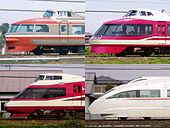- Odakyū 3000 series
-
This article is about Odakyū 3000 series commuter trains. For Odakyū 3000 series SE Romancecar trains, see Odakyū 3000 series SE.
Odakyū 3000 series
Odakyū 3000 seriesIn service 2002–Present Manufacturer Kawasaki Heavy Industries, Nippon Sharyo, Tokyu Car Corporation Constructed 2002–2010 Number built 320 vehicles (47 sets) Number in service 312 vehicles (47 sets) (as of April 2010) Formation 6/8/10-car sets Operator Odakyu Electric Railway Depot(s) Ebina Specifications Car body construction Stainless steel Car length 20 m (65 ft 7 in) Doors 4 pairs per side Maximum speed 100 km/h (62 mph) Acceleration 3.3 km/h/s Electric system(s) 1,500 V DC Current collection method Overhead lines Safety system(s) OM-ATS Gauge 1,067 mm (3 ft 6 in) The Odakyū 3000 series (小田急3000形) is a commuter electric multiple unit operated by Odakyu Electric Railway in Japan since 2002. First introduced on 10 February 2002, a total of 312 cars were built in 8 batches with orders divided between Nippon Sharyo, Tokyu Car Corporation and Kawasaki Heavy Industries. Originally formed as 6- or 8-car formations, a further eight cars were built in late 2010 to augment to 6-car sets to 10 cars.[1]
Contents
Formations
10-car sets
Designation Tc1 M1 M2 T1 T2 M3 M4 T3 M5 Tc2 Numbering 3050 3000 3100 3150 3250 3200 3300 3350 3400 3450 The M1, T1, M3, and M5 cars each have one single-arm pantograph.[2]
8-car sets 3651–3665
Designation Tc1 M1 M2 T1 T2 M3 M4 Tc2 Numbering 3650 3600 3700 3750 3850 3800 3900 3950 The M1, T1, and M3 cars each have one single-arm pantograph.[3]
6-car sets 3251–3262
Designation Tc1 M1 M2 M3 M4 Tc2 Numbering 3250 3200 3300 3400 3500 3550 The M1 and M3 cars each have one single-arm pantograph. Sets 3252 to 3254 have wider doors.[3]
6-car sets 3263–3282
Designation Tc1 M1 M2 T M3 Tc2 Numbering 3250 3200 3300 3350 3400 3450 The M1 and M3 cars each have one single-arm pantograph.[3]
See also
 Media related to Odakyu 3000 series at Wikimedia Commons
Media related to Odakyu 3000 series at Wikimedia Commons
References
- ^ "小田急3000形10輌固定編成 試運転 [Odakyū 3000 series test run as 10-car set]" (in Japanese). Tetsudo Hobidas. Neko Publishing. 7 December 2011. http://rail.hobidas.com/rmn/archives/2011/01/300010.html. Retrieved 8 January 2011.
- ^ "小田急電鉄3000形 中間車製造と10両固定編成化 [Odakyu 3000 series - New intermediate car production and lengthening to 10-car sets]". Japan Railfan Magazine (Japan: Kōyūsha Co., Ltd.) 51 (602): p.72–75. 2011.
- ^ a b c 私鉄車両編成表 2010 [Private Railway Rolling Stock Formations - 2010]. Japan: JRR. August 2010. p. 47. ISBN 978-4-330-15310-0.
External links
 Media related to Odakyu 3000 series (II) at Wikimedia Commons
Media related to Odakyu 3000 series (II) at Wikimedia CommonsOdakyu trainsets Romancecar 
Commuter Categories:- Electric multiple units of Japan
- Odakyu Electric Railway
Wikimedia Foundation. 2010.

